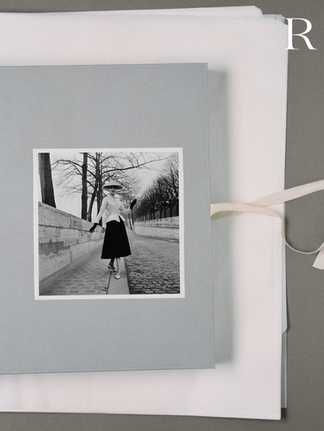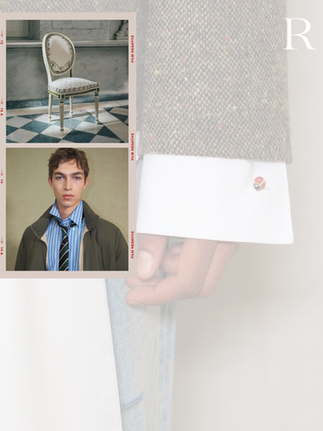Dior, Disrupted: Anderson’s First Strike
- Paula Martinez
- Jul 1
- 4 min read
Photos Courtesy of @Dior & @Jonathan.anderson / Graphic designer by Francesca de Vita
Jonathan Anderson stormed into Dior Men in January 2025, slipping effortlessly into the shoes of Kim Jones and Maria Grazia. But this debut was more than a new chapter, it was a full-blown reset. For the first time since Christian Dior himself, one designer holds the reins of the entire house: menswear, womenswear, and haute couture. Anderson isn’t here to play it safe, he’s here to rewrite the rules thread by thread.
Rebel with a Couture Cause
Jonathan Anderson is far more than a designer; he is a visual storyteller who crafts each collection as conversation between history, culture, and identity.
From his early days bringing Loewe back on track, Anderson revealed a unique sensitivity for marrying textures and reinterpreting classic silhouettes through a modern, provocative lens. His work consistently explores the tension between luxury and utility, formality and ready to wear, challenging the boundaries of gender and tradition.
His creative process is meticulous and collaborative, engaging master artisans and ateliers to co-create pieces that transcend clothing to become objects of desire and conceptual statements. In this way, Anderson doesn’t just design fashion he orchestrates an immersive aesthetic experience that pushes conventions and redefines the very essence of style.
Not Leak, A Lure
This wasn’t a rollout; it was a slow-burning ritual. A quiet detonation of expectation. No teasers, no leaks, just the elegant pressure of silence. The strategy was less marketing, more mise-en-scène.
The result? An audience was already spellbound before a single look hit the runway. He didn’t simply present a collection. He hinted at it. He staged it. He transformed it into a poetic rite of passage.
Echoes & Edge
“As I started out on this journey, I kept returning to photographs of Basquiat and Radziwill, who are, for me, the epitome of style,” Anderson said. From this tension, between artistic rebellion and aristocratic elegance sprang a show less about clothes and more about language. Set in a stark, gallery-like space inspired by the still lives of Jean-Baptiste-Siméon Chardin flowers in a Delft vase, a bowl of strawberries. The show turned simplicity into spectacle.
Each garment functioned like a tableau vivant: part memory, part provocation. Whispers of Warhol, Dracula, and Les Liaisons Dangereuses infused the atmosphere, playing with nostalgia and rupture. The cultural significance of the event was underscored by the attendance of a star-studded crowd including Pharrell Williams, Sabrina Carpenter, Daniel Craig, Robert Pattinson, Donatella Versace, Rihanna and A$AP Rocky.
Everyday Sublime
The collection opened to the haunted pulse of Springsteen’s “State Trooper,” transitioning into the sultry throb of New York’s “Makeout” and the electric jolt of “Hi.” A sonic arc as daring as the garments themselves.
Proposes a fluid, theatrical, and almost naïve masculinity. It’s as if someone took the classic male wardrobe and remixed it with that of a child playing dress-up. There’s no fear of looking ridiculous, and that’s entirely deliberate.
Between a preppy look, the reinterpretation of the Dior 1950’s bar jacket. Layered trousers with serious volume, bow-tie collars stealing the spotlight, and colourful vests moiré made, injecting a burst of energy. Tailored blazers in rich tweed and plush velvet brought sharpness reinterpreting the Dior’s 1950’s iconic “ Bar Jacket “ , while technical shorts added a sporty edge.
Out of nowhere, scarves made a bold entrance, and pleated coats added a twist of drama. The perfect low-waist, faded denim nailed that effortless cool, balanced by sleek suit pants and both printed and solid capes that fluttered with attitude. While cropped blazers and head-to-toe denim looks kept things modern and fresh. Striped ties and cable-knit sweaters rounded out the mix, creating a dynamic dance between vibrant pops of unexpected colour and understated neutrals, a fearless playbook of contrasts that feels both electric and effortlessly cool.
Unique fringed bags mixed effortlessly with nylon backpacks and Dior’s signature monogram classics. And with a cheeky wink, the iconic Dior Book Tote made its comeback this time shrouded in gothic Dracula script, adding a darkly plot twist.
Prince Charming in chunky sneakers and fisherman sandals worn with socks elements that, on paper, shouldn't belong in the same universe somehow made perfect sense on Anderson’s runway.
The unexpected clash of fairytale elegance and utilitarian awkwardness created a visual friction that felt intentional, even clever. What could have been a stylistic misstep instead became a quiet subversion of fashion logic, proving that in Anderson’s Dior, contradiction isn’t just allowed, it’s the point.
Disrupting Tradition
Anderson brings to Dior not just a new aesthetic, but a renewed ideology: style as a way of being, not just a way of dressing. His vision interrogates Dior’s legacy rather than simply evolving it. Historical garments like the 18th century are reconstructed with contemporary volume, raw textures, and deliberate irony.
Regimental ties and rose brocades shed their elitism, remade with irreverent affection. Anderson unearths Dior’s codes to build something entirely new from their bones.
Stitching a New Order
This wasn’t a collection, it was a manifesto in motion. A fierce, intelligent ode to craft and contradiction. A call to inhabit style rather than merely perform it.
Under Anderson, Dior becomes less a heritage house and more a living archive; unstable, electric, full of seductive risk. Because in this new Dior, tradition isn’t preserved; it's twisted, glamorized, deconstructed, and detonated in broad daylight. And now, as the smoke clears and the spectacle settles, one question lingers like a wicked aftertaste:
"Rebirth or rebellion: Has Dior been reinvented, or is this just Anderson’s opening act?
“ With just a blink, I knew it was Jonathan Anderson—every brushstroke of the show radiated his unmistakable signature, though cloaked in the language of Dior. But here’s the real thought: is the designer now taking up so much space that Dior’s own identity is fading into the background? And if that’s the case… maybe it’s not the designer who needs saving. Maybe it’s Dior. “































